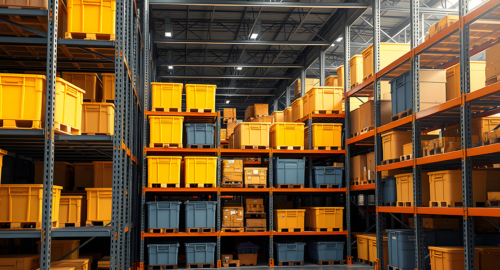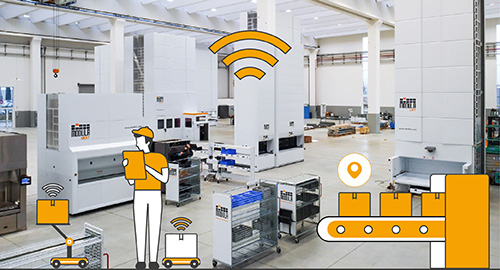It is plain to see that global supply chains are going through some tough times and the COVID-19 pandemic has made things even worse. The main reasons for the difficulties are as follows:
- shortages of raw materials
- labour shortages
- increased demand.
In this post, we will focus in particular on the labour shortages in supply chains and logistics, the reasons behind them, the problems that they cause and how they can be resolved.
Which factors led to the labour shortages?
The following definition of labour shortages is used by the European Commission:
“Labour shortages occur where the demand for workers in a particular occupation exceeds the supply of workers who are qualified, available, and willing to do that job.”
There are many factors behind the labour shortages in supply chains and logistics. They can be either general (i.e. regarding the whole of the economically active population) or specific (regarding the characteristics of the field). These factors are compounded by other issues and mean that supply chains stop flowing and develop bottlenecks that slow them down or even bring them to a complete halt in the worst cases.
Which fields are worst affected by chronic staff shortages? Topping the list is hospitality (51%), which is followed by health and social care (49%), and then manufacturing (47%). There are also very high rates in transport and storage (36%) and retail (31%) [Source: Labour Market Outlook Summer 2021].
The ageing population in the eurozone
The problem with labour shortages stems not only from sociological issues, but also from a trend that will be difficult to reverse: the population of Europe is inexorably ageing. According to a study conducted by the United Nations, Europe will have 95 million fewer working-age people (between 20 and 64 years of age) in 2050 than in 2015.
As a result of the population ageing, the number of people entering the labour market is lower than the number of those leaving it. This problem has had – and continues to have – a particularly significant impact on the world of logistics and supply chains. Work in the field is of a manual and physical nature. It is considered to be very strenuous and therefore unappealing for young people and unsuitable for older workers.
Changes brought about by the COVID-19 pandemic
The COVID-19 pandemic has led to huge changes in people’s habits and lifestyles, as well as restricting freedom of movement. This has had repercussions on workforce availability in various fields for a number of reasons:
- many migrant workers returned to their home countries during the pandemic and did not go back to their jobs when the situation improved;
- people left industries that are seen to be “dangerous” from a health point of view, opting for jobs that are deemed safer;
- restrictions of freedom of movement – which has yet to be restored to pre-pandemic levels – have affected the flows of migrant workers.
Skills mismatch between supply and demand
Due to the movement of workers into fields that are considered safer or that did not have to suspend operations during the pandemic, there is a substantial mismatch between the skills required in the world of work and those that are available.
The situation worsened after work started up again in the manufacturing industry and consequently in the production and supply chains, where there is a shortage of key skilled figures. This has led to a general slowdown in deliveries and production because there is not enough staff available to cater to the demand.
What does it mean to work in logistics and supply chains today?
One of the reasons behind the labour shortage in supply chains and logistics is the mistaken belief that all of the work is of a tiring, physical nature and thus unappealing. This notion is far removed from the actual state of affairs in logistics 4.0: more and more logistics and supply chain companies are adopting cutting-edge software and technological systems to boost the efficiency of their operations, improve the working conditions of their staff and protect their health and safety. For example, they use more ergonomic systems that help to reduce the risk of accidents.
It is also one of the fields in which the impact of activities all along the production chain is being reassessed in a process that revolves around sustainability of all kinds, including on the environmental front. It is hard to find qualified staff to work in logistics today because of the difference between the workforce’s perception of the industry and the actual situation in terms of the working conditions and skills required.
Ways for supply chains to make up for the decrease in the labour supply
In 2021, filling vacancies for key positions in supply chains proved to be particularly difficult: 36% of the employers interviewed for the Summer 2021 Labour Market Outlook report stated that they had trouble finding staff, compared to 26% in the previous year.
Companies and supply managers can deal with labour shortages in a variety of ways:
Improving communication
Given that people clearly have mistaken views about the working conditions in supply chains, companies should change the way they communicate with the labour market in order to find qualified staff in strategic sectors such as transport and logistics. This is even more essential because the majority of the potential candidates are Millennials and members of Generation Z who have mistaken beliefs and a lack of trust in the industry.
Investing in automation and technology
Supply chain decisions can be data-driven, goods can be processed and handled using automation and mobile robots, and wearable devices can make work easier for staff. All of this helps to make the industry more attractive and means that jobs today have more in common with clerical and management roles than manufacturing jobs. Candidates are required to have an increasingly broad range of both physical and technical skills. If the supply chain is automated and run with technological support, the field will be more attractive.
Increasing storage spaces
COVID-19 has highlighted the limitations of just-in-time logistics. It is a production model that can be put under great strain by fluctuations in the market, and labour shortages further restrict its capacity to respond to surges in demand. Increasing just-in-case stocks gives greater resilience and makes it possible to respond to peaks in demand promptly even if there are labour shortages, but only if the warehouse and logistics systems have certain characteristics.
Logistics 4.0 as a solution to the supply chain crisis
While logistics and increasing stock can be a new frontier in improving the resilience of modern supply chains, they do lead to two potential issues:
- overburdening staff
- a lack of floor space.
Once again, the solution can be provided by technology.
Autonomous mobile robots and wearable devices
Artificial Intelligence companies have developed high-performance autonomous mobile robots to help logistics staff to handle, load and unload goods.
Supply chain and logistics companies are well aware of this and use of these solutions is soaring: Brain Corp reported 226% growth in the floor area covered by its AMRs between April and October 2021.
This underlines how receptive the industry is to technological innovation and the indispensable role played by this innovation in meeting the requirements of logistics today. An autonomous mobile robot has the capability to work non-stop at a pace that would not be humanly possible, thus making it easier to deal with peaks in demand.
Meanwhile, members of staff are relieved of their more physically demanding duties and can focus on the supervision and planning side of things. In addition, wearable devices can help them to notice any difficulties in the warehouse quickly and take the necessary action.
Autonomous storage systems
Increasing stock to boost resilience inevitably means that more storage space is needed. As well as finding warehouses with more floor area, another way to increase capacity is to optimize the space used.
In the latter case, the obvious answer lies in vertical storage systems, which stretch upwards and make the most of the space available in all directions. Automatic storage systems such as the Modula Lift are based on the goods-to-person approach. A central lift system moves trays from the storage sections to the picking bays, where the materials are delivered to the staff in ergonomic positions.
Another advantage of autonomous storage systems lies in that they can be fully integrated with technological warehouse management systems, increasing the speed and overall efficiency of warehouse operations without leading to excessive stress or physical workloads for staff. Modern picking solutions make work easier for pickers and automatic storage systems the number one choice among companies looking for cutting-edge ways to improve performance and working conditions.
Download our in-depth analysis to find out how reorganizing your warehouse can improve staff satisfaction and make working in logistics a more appealing prospect.
The advantages of a Modula automatic vertical storage system



